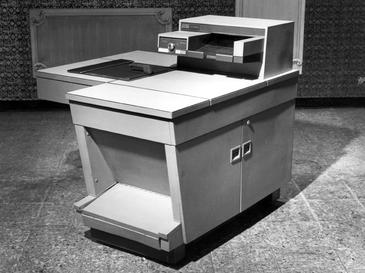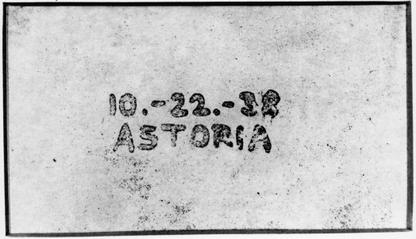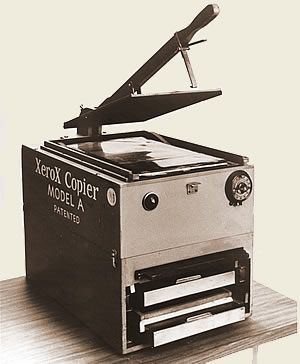Lessons from the Xerox-914: the first copy machine
A great innovation in business tech was announced on Sept. 16th in 1959 – The Xerox 914. It is one of the great breakthroughs in office technology and product design.
It was the first copy machine that resembles the ones we know and the inventions inside it led to the laser printers we use today. It’s hallmark was simplicity: unlike it’s complex competitors, you simply placed your paper on glass and pressed a button. How Chester Carlson invented it is a great story of risk and persistence and a better one to learn from than most.

Carlson worked at Bell Labs in the 1930s in the patent department. He had 100s of ideas for different inventions, but focused on copying because typing with carbon paper was messy and frustrating (You had to place a sheet of the carbon paper between two sheets of regular paper, and writing or typing would be copied to the second sheet). His patent department made hundreds of copies and he found the process frustrating. The “cc:” line in email applications today is a reference to the manual process of making a carbon copy,.
Carlson was fired in 1933 (Great Depression). By 1936 he had a new job and went to night school to study law. Too poor to buy books, he had to hand copy them from the library! Copying was his nemesis. To relax he read books on science, and there he learned about Pál Selényi’s work on electrostatic images and he saw a way for his idea to become real.
He did chemical experiments in his own home, to the annoyance of his family and neighbors. He made unavoidably smelly compounds, melting sulfur (!) over zinc plates in the kitchen smelling like rotten eggs, once even starting a fire. By 1938 his wife told him he had to do his work elsewhere..
Using Selényi’s ideas (roughly: use light to remove static charge, not create it) and his own, after many experiments he had a ‘breakthrough’ in 1938. But unlike the myth of epiphany, he realized that moment depended on many others:
“Things don’t come to mind readily, all of a sudden, like pulling things out of the air”
This is the first xerox copy in history.

He soon had a patent but more rough times were ahead. Between 1939 and 1944 he was turned down by 20 companies, including IBM and the U.S. Navy.

He and his wife Elsa von Mallon soon divorced. He described the marriage as “an unhappy period interspersed with sporadic escapes.” Perhaps those kitchen fires and terrible smells made him a hard man to live with.
Carlson continued to work in patents at the P. R. Mallory Company. One day he was able to demo his work to an engineer from Battelle, who was only there his employer’s office to testify for a patent case. Battelle never took in outside ideas but were impressed and offered financial support. It only took 20 YEARS, but he finally had support for his idea.
In 1946 they signed a deal with Haloid (later to be renamed Xerox), a competitor to Kodak. In 1948 they released the Xerox Model A Copier. It took 39 steps to make a single copy.

Another decade of development led to the Xerox 914 – named because it could copy paper up to 9″ x 14″. This model become popular quickly because it:
- was simple to use
- didn’t damage originals
- could be rented
- used regular paper
It took almost 30 years but Carlson’s dream was finally real. At the push of a button you could make a perfect copy.

As innovative as it was, as with most new tech it had some problems.
It tended to overheat (one demo model caught on fire on launch day), often enough that it came with a “scorch eliminator” – a sales friendly term for fire extinguisher. Ralph Nader’s machine caught fire 3 times in 4 months and he complained to the press about it.
Even so, they had great sucecss marketing it on ease of use – including a TV ad where a young girl, Debbie, makes copies.
A follow up ad used a chimpanzee, but led to harassment for secretaries and was rarely used.
Compared to today it’s true these machines were:
- large
- hard to maintain
- fragile
- unreliable, as paper jams (‘mispuff’) happened often
The machines often required a small team of people who maintained them and managed taking in copy requests and delivering them (the copy room). But relative to competitors it was a breakthrough in many ways and these issues were improved over time.
The story of Xerox and Carlson is a great example to learn from – it doesn’t suffer from any of the Myths of Innovation. The time from having an idea to making it a real product in the marketplace took decades, which is more often the case than most people realize.
His patents made him wealthy enough to retire. He gave most of his fortune away, anonymously, including support for Buddhism, NYCLU and the NAACP. He died in 1968.
References:
en.wikipedia.org/wiki/Chester_C…
amazon.com/Copies-Seconds…
cosmosmagazine.com/technology/sci…
en.wikipedia.org/wiki/Battelle_…
books.google.com/books?id=ZYurh…

This is one of my absolute favorite stories in innovation because I could not run my toner supply business today if not for Chester Carlsons innovation. It is phenomenal innovation. Great job Scott.
Carlson had an assistant named Otto who despite helping Chester with many of his advancements, Otto passed up on a royalty offer from Chester that would have turned out to be a large fortune. Instead Kornei worked for Carlson for six months and then left. I believe Carlson sent him stock later on in appreciation but it’s a testament to Carlsons optimism that his own assistant thought he was in a fantasy world.
for a fun overview of the invention, “the Secret Life of Machines” (https://secretlifeofmachines.com) did an episode on the photocopier https://www.youtube.com/watch?v=S2NIAD5qn7E
including attempts at recreating the experiments with the sulfur.
Fascinating look back at the invention of something we take for granted today!
This is also one of the times where a company name (or brand) becomes synonymous with a word and/or becomes a verb:
I know someone (OK, it’s my mom!) who uses the word “Xerox” as a verb to mean “make a copy”. Many people think “Kleenex” (a brand name) is just another English word for tissue). And, of course, who hasn’t told someone they “Googled” something?